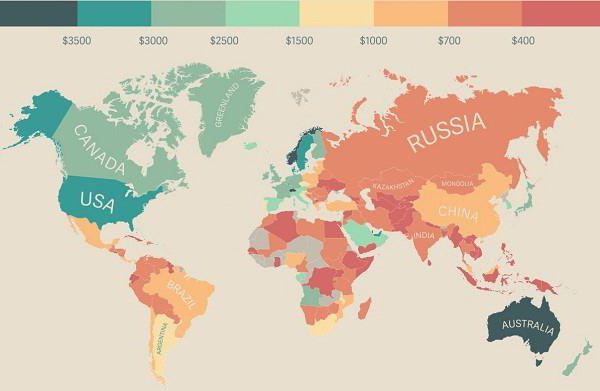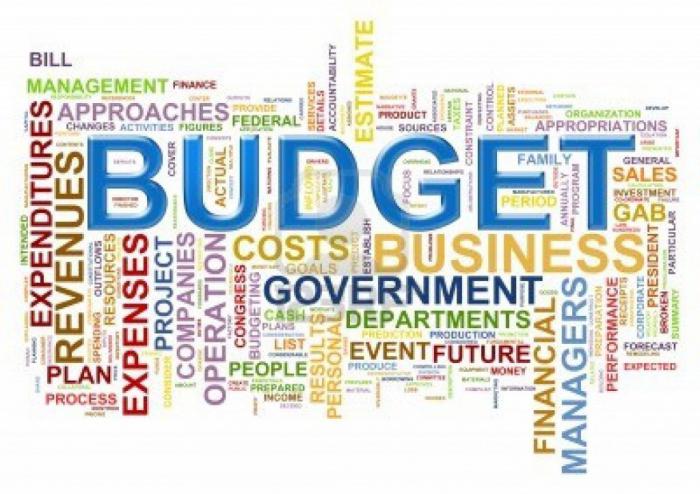Population income - this is the aggregate of all material resources that employees, employees and other persons receive for labor in a particular sphere as a result of their economic activity or as transfers.
The essence of the concept
In a simpler form, one can say that income is the amount of money received in a certain unit of time for performing a certain work. For example, 20 thousand / month. Sources of income can be:

- Salary (time and piecework).
- Other income of employees from enterprises in addition to wages: bonuses, remuneration, etc.
- Income from doing business.
- Revenues from the disposal of private property.
- Revenues from the sale of foreign currency of another country at a higher rate than the currency was acquired.
- Other miscellaneous income.
Transfers
In addition to economic activity, income can come in the form of transfers. We will explain this part in more detail.
By transfers is meant the giving by one person of certain goods to another free of charge. Also transfero translates as “move” or “transfer”. In this case, the transfer can be understood in a more general sense - the change of location of funds in a certain form or only their owner.
For example, the state pays a pension to older people - this is a transfer. In addition, such income includes:
- Wealth. This category includes hereditary acquisitions: money, real estate and movable property, documents, etc.
- Fines.
- Voluntary donations and contributions from individuals and legal entities.
- Social benefits: unemployment benefits, single mothers, people with disabilities, funeral, childcare, etc.
- Social protection of the population (compulsory social insurance).
Population income level
For each country, the level of income of the population is important. It can be used to determine the welfare of the country with the greatest accuracy. Unlike per capita incomes, economists receive more detailed and truthful information, as indicators of average nominal, disposable and real incomes are used to assess income levels:
1. Nominal - in-kind or cash income received by a citizen of a country for a certain time for a certain job.
2. Disposable is nominal income minus mandatory payments to the state or private enterprises. Income that can be used by a citizen to meet needs.
3. Real - some wealth (goods and services) that a citizen can acquire in the amount of real income for a certain time.
The term “income level of the population” is invariably associated with national well-being, the degree of satisfaction of the spiritual and material needs of citizens. And most importantly, it is associated with living standards of the population. So, for economists, income indicators have the following meanings:
- Comparison - a comparison of the values of individual indicators of income of citizens in the time or geographical (between different territories, between countries) interval.
- Studying the impact of social transformations (for better or for worse).
- Accounting for disagreement in income between different segments of the population.
General form

Revenues are usually divided by type (form) and method of use. The population receives them in cash or in kind.The monetary form is salary, dividends, documents of value during the sale (the right to own private property, movable property). The natural form is expressed in the farms' own work of the necessary objects for life. For example, farmers grow carrots and potatoes (food) in the garden or flax and cotton, from which clothes can be sewn.
Natural incomes of the population are produced and used by consumers. For example: this type is typical for farms, private plots, individual small towns and villages in any country. It is not worth attributing in-kind acquisitions only to countries with a backward economy.
Cash incomes of the population are used by citizens to purchase ready-made material needs. This is the purchase of necessary goods and services.
Real income
Real incomes of a population are a set of material goods, expressed in kind, which a consumer can acquire, having his own nominal income. Sometimes people confuse nominal and real incomes. Real earnings characterize the number of material goods bought by a person, given the variation in retail prices, the percentage of taxes, etc.
To determine the real incomes of the population with the greatest accuracy, it is necessary to subtract the mandatory costs of direct and indirect taxes and obligatory payments from the total amount of all earnings (monetary + in kind). This refers to contributions, excise tax, VAT, overpayments for services, etc.
It is worth noting that real incomes of the population are an indicator of the life of society in a given country. For example, capitalist relations are characterized by rapid, uneven growth in cash receipts and their sharp decline in certain periods. Such incomes of the population can suffer a decline for many reasons:
- Constant state-uncontrolled price increases for certain goods and services.
- Inflation (increase in the general price level).
During the formation of social society, the overall level of real income is gradually increasing. However, it is worth remembering that revenues are distributed unevenly. In particular, in Russia from 1940 to 1976 the income of farms and communities was much higher than the workers of any plant. But compared with the beginning of the 20th century, the total real income of the same workers grew by about 3.5 times. If we talk about the population as a whole, then almost 5 times.
Populated incomes
According to entrepreneurs, income is the excess of the amount of sales from the amounts needed for production costs. And production costs are considered not only the purchase of all necessary materials, but also the wages of workers, employees and managers. So, the average annual income of an individual in a country is per capita income. It is calculated on the basis of the sum of all material assets for a year of persons of the same class.

Per capita income has been introduced into economic terms to show the welfare and economic situation of a country. It can easily be used to determine the level of modernization and development of a country for any period of time.
An analysis of the statistics of per capita incomes in different countries of the world allows us to say with confidence that the majority of the world's population lives in countries with average earnings that do not exceed $ 350.
However, per capita income gives an overly broad picture; it does not consider individual details. For example, according to statistics, by average income it is impossible to know the purchasing power of different segments of the population.
And if we consider the underdeveloped countries? For an average European, most of his income goes to providing for his life. This is clothing, food, housing costs, etc. But in underdeveloped countries, many people live on self-sufficiency (grow food, sew clothes, build housing) and, therefore, spend on it a little differently.This means that these items will not be reflected in the national income of an underdeveloped state.
And finally, the statistics of per capita incomes in a country cannot provide reliable information about the state of a country if it has a strong uneven distribution of income. It is about the contrast between the rich and the poor.
Nominal income
The easiest form of income — nominal income - represents the total amount of all income of an individual or enterprise from a certain activity. Nominal incomes of different segments of the population are formed according to some laws:

- Income in the form of wages, wage workers, or property income.
- State transfers - transfers.
- Income received through the financial credit system: state insurance, bank loans, etc.
Returning a few years to the past, in the beginning of the 90s, we can recall that at that time Russia had the lowest nominal incomes. According to the average statistics of the Federal State Statistics Service, monthly cash receipts did not exceed $ 22! Until about 1995, the conditions of extreme poverty were held in Russia. But in 2006-2007, the Russian Federation again managed to return the economic situation of the population to the same level that it was in 1990.
Population income
The country's economy is firmly supported by the income of each individual citizen. So, it is necessary to raise the standard of living to the maximum possible. At present, the incomes of the Russian population are distributed as follows:
- Payment is temporary and piece-rate - salary - 66.8%.
- Social insurance payments - 18.2%.
- Entrepreneurial income - 7.8%.
- Disposal of property - 5.3%.
- Incomes of other types - 1.9%.
Incomes of the population of Europe and the CIS are distributed a little differently. In the West, far more people are engaged in entrepreneurial activities and receive less payments on social insurance.
The highest income levels are observed in the countries of North America - Canada and the USA, as well as in Australia. The average monthly income of residents of these states reaches $ 3,000.
The lowest level is in Central and South Africa. There is no reliable information on the incomes of many territories, and in other states the average earnings are hardly $ 100. However, it is worth remembering that agricultural production reigns on this continent, and it is not taken into account in the calculation.
The growth of population incomes is the main task of the economy of any state. Each country at a certain point in its existence experienced severe economic crises, unrest in society due to lack of resources, etc. But the rulers of all territories of the Earth, without exception, seek to improve the life of the population and increase the average income.

How are incomes distributed?
The primary distribution of income, in the economy it is also called functional, begins with the distribution of them between the owners of factors of production. In different periods in different countries, different systems of formation of the distribution of incomes have acted and are functioning, but in general there are four main aspects:

- Equalization, or egalitarian distribution, is an attempt to equalize the incomes of all segments of the population. However, this aspect cannot be considered successful. Since the physical and mental abilities of individuals in one country vary greatly, egalitarianization will create a situation where one works and the other eats.
- Distribution by market method. A fairer way of distributing income, based on the public benefit of the product produced and sold by the entrepreneur. So it is impossible to establish an absolute balance in income, but their distribution will be fair.
- With the help of accumulated property. Such a distribution of household income is manifested in the receipt, accumulation and inheritance of any part of the accumulated property: home, securities, money, etc.d.
- Privileged distribution, most developed in countries with backward democracy. The simplest form of distribution is where wealthy officials and rulers autonomously redistribute income in their favor: they arrange higher wages, pensions and other benefits.
Many people, living quietly within their own country, do not notice how the economic system rules them. And it is very good that an ordinary person does not notice how the state intervenes in a market economy.
If the majority of people feel that incomes are being distributed dishonestly, that someone is managing them, and that the employees' own efforts do not bear any fruit, this is fraught with dissatisfaction of the lower strata.
Population expenses
If citizens have incomes, and expenses of the population also take place. In well-developed countries, the income of any person should be more than the cost. Then a full and progressive existence of each individual in society is possible. At the moment, in Russia, most of the population lives in this way. But it was not always.
In economics, there is such a thing as decile coefficient or stock coefficient characterizing the degree of stratification of society (the difference between the richest citizens and the poorest). When taking for ratios the total income of 10% of all the richest citizens of the country and the poorest, this coefficient should not exceed 9-10 (according to the recommendations of the UN).
In the early 90s, after the collapse of the USSR, the decile coefficient was officially 16, but in fact its threshold reached 28-32. This means that the incomes of the poor in Russia were below the subsistence level by more than 3 times.
This difference between the earnings of the rich and the poor allows us to understand that it was not in the distant past that the economy of the Russian Federation was experiencing a real collapse and had to rise from the ruins.
Low population incomes for the country's economy threaten with a state budget deficit. If the nominal income of an individual will be less than the sum of the cost of the necessary material goods, then what can we say about the payment of direct and indirect taxes and the level of development of the state?
The main reason for low state revenues is the one-sidedness of demand. When only goods of one product are in demand on the market, and other manufacturers are storing a product unsuitable for the masses, a bilateral situation arises. If you look from one angle, the income of the sought-after producer will go up, but, on the other hand, the same reason is considered the main premise of the monopolies, because of which there is a strong contrast between the rich part of the population and the poor. In no case can such a thing be allowed, therefore the state monitors supply and demand on the market with particular care.
So, one of the main tasks of the Ministries of Finance in Russia and their analogues in other countries is to increase the cost of living, the average wage and to reduce the decile ratio as much as possible.
Let now far from all the aspirations of economists and ideologists can be fulfilled in practice, or at least put together a project to introduce them to the masses. But if we compare the current standard of living and the one in which people were obliged to exist in the middle of the 20th century or even earlier, at the end of the 19th, then we can say with confidence that the economy of the leading countries of the world is progressing at an incredible rate. For example, after the collapse of the USSR, Russia took about 10 years to return to its previous standard of living. Since then, our state has been progressing economically.
Do not confuse the different types of income of individuals, but you definitely need to know that everyone is able to contribute to the development of the country's economy and help it rise to the top of the global economic industry.

